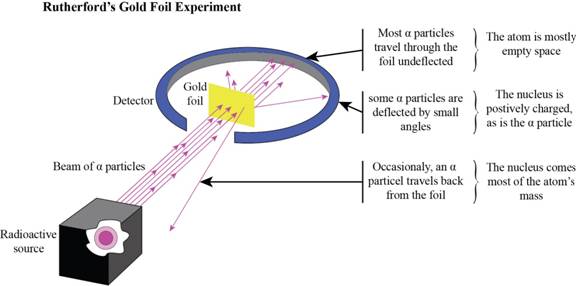
Concept explainers
(a)
Interpretation: The density of the electrons in the atom to be calculated.
Concept Introduction:
Atoms: Atoms consist of tiny particles called protons, neutrons and electrons. Proton and neutrons are present in the nucleus and the electron resides around the nucleus. The protons number will be same as the electrons count in the atom.
Nuclear stability: The nucleus is composed of protons and neutrons. The strongest nuclear force binds the particles tightly. Though the protons repel each other due to no attraction between similar charges, possess short-range attractions made the attraction possible between proton and proton, proton and neutron, neutron and neutron.
The stability of any element is determined by the difference between coulombic repulsion and the short-range attraction. If repulsion outweighs the attraction, the disintegration of nucleus occurs by producing the daughter nuclides. If the attractive forces prevail, the nucleus is stable.
(a)
Answer to Problem 2.82QP
The atom consists of concentrated mass called nucleus at the center and surrounded by the electrons.
Explanation of Solution
Every atom contains a nucleus in which all of its positive charge and most of its mass are concentrated is proven by the experiment.
Experiment: Allowing alpha-particles (positively charged) to bombard with the gold foil, expected all the rays to pass through. In contrast, the rays are deflected with angles is observed.

Rutherford’s Experiment evidences about:
- 1. The atom is mostly consist of empty space (due to most of the rays went through the foil).
- 2. Very solid particles; presence of nucleus is revealed by the rays were bounced back.
- 3. The nucleus consist of positive charge is confirmed by the rays deflected at an angle. The similar charges have no attraction and are deflected away.
(b)
Interpretation: The density of the electrons in the atom to be calculated.
Concept Introduction:
Atoms: Atoms consist of tiny particles called protons, neutrons and electrons. Proton and neutrons are present in the nucleus and the electron resides around the nucleus. The protons number will be same as the electrons count in the atom.
Nuclear stability: The nucleus is composed of protons and neutrons. The strongest nuclear force binds the particles tightly. Though the protons repel each other due to no attraction between similar charges, possess short-range attractions made the attraction possible between proton and proton, proton and neutron, neutron and neutron.
The stability of any element is determined by the difference between coulombic repulsion and the short-range attraction. If repulsion outweighs the attraction, the disintegration of nucleus occurs by producing the daughter nuclides. If the attractive forces prevail, the nucleus is stable.
(b)
Answer to Problem 2.82QP
The density of the electrons is
Explanation of Solution
Calculate the density of the nucleus.
Consider, the nucleus is spherical, and the volume of the nucleus is:
In order to calculate the density, the value of volume is must; which is calculated as shown above by considering the nucleus is spherical.
Calculate the density of space occupied by electrons in sodium atom.
To be required: The mass of
The volume occupied by the electron is obtained by the differences between the volume of the atom and volume of nucleus.
The volume of atom is:
Hence, the required terms are sufficient to calculate the density of the electrons:
The density of the electrons is
Want to see more full solutions like this?
Chapter 2 Solutions
GEN COMBO CHEMISTRY: ATOMS FIRST; ALEKS 360 2S ACCESS CARD CHEMISTRY:ATOMS FIRST
- Can I get helpp drawing my arrowsarrow_forwardWhich of the m/z values corresponds to the base peak in the mass spectrum shown? 100 80 A. 45 B. 44 C. 29 D. 15 Intensity 20 0 10 20 30 40 B- m/z -8 50 E. 30 Which of the m/z values correspond to the molecular ion for the compound shown? A. 18 B. 82 OH C. 100 D. 102 E. 103arrow_forwardCan someone help me with drawing my arrows.arrow_forward
- I'm having trouble with converting lewis diagrams into VSEPR diagrams. I currently have this example of C2BrCl3 which I want to turn into a lewis structure, but I'm not sure what steps I need to do in order to do so. I have the table written down, however, there's two central atoms so what would I do? There seems to be 4 electron domains on the carbon atom and no lone pairs so it would seem like this shape would be tetrahedral. Here's what I have now. Thanks!arrow_forwardWe discussed the solid phase resin using in peptide synthesis. Provide a mechanism, for its formation. DRAW THE MECHANISM.arrow_forwardPlease help. Every time I've asked an expert in the past, it's been wrong :(arrow_forward
 Chemistry: The Molecular ScienceChemistryISBN:9781285199047Author:John W. Moore, Conrad L. StanitskiPublisher:Cengage Learning
Chemistry: The Molecular ScienceChemistryISBN:9781285199047Author:John W. Moore, Conrad L. StanitskiPublisher:Cengage Learning Introductory Chemistry: A FoundationChemistryISBN:9781337399425Author:Steven S. Zumdahl, Donald J. DeCostePublisher:Cengage Learning
Introductory Chemistry: A FoundationChemistryISBN:9781337399425Author:Steven S. Zumdahl, Donald J. DeCostePublisher:Cengage Learning Chemistry: Principles and ReactionsChemistryISBN:9781305079373Author:William L. Masterton, Cecile N. HurleyPublisher:Cengage Learning
Chemistry: Principles and ReactionsChemistryISBN:9781305079373Author:William L. Masterton, Cecile N. HurleyPublisher:Cengage Learning Chemistry & Chemical ReactivityChemistryISBN:9781337399074Author:John C. Kotz, Paul M. Treichel, John Townsend, David TreichelPublisher:Cengage Learning
Chemistry & Chemical ReactivityChemistryISBN:9781337399074Author:John C. Kotz, Paul M. Treichel, John Townsend, David TreichelPublisher:Cengage Learning Chemistry & Chemical ReactivityChemistryISBN:9781133949640Author:John C. Kotz, Paul M. Treichel, John Townsend, David TreichelPublisher:Cengage Learning
Chemistry & Chemical ReactivityChemistryISBN:9781133949640Author:John C. Kotz, Paul M. Treichel, John Townsend, David TreichelPublisher:Cengage Learning General Chemistry - Standalone book (MindTap Cour...ChemistryISBN:9781305580343Author:Steven D. Gammon, Ebbing, Darrell Ebbing, Steven D., Darrell; Gammon, Darrell Ebbing; Steven D. Gammon, Darrell D.; Gammon, Ebbing; Steven D. Gammon; DarrellPublisher:Cengage Learning
General Chemistry - Standalone book (MindTap Cour...ChemistryISBN:9781305580343Author:Steven D. Gammon, Ebbing, Darrell Ebbing, Steven D., Darrell; Gammon, Darrell Ebbing; Steven D. Gammon, Darrell D.; Gammon, Ebbing; Steven D. Gammon; DarrellPublisher:Cengage Learning





